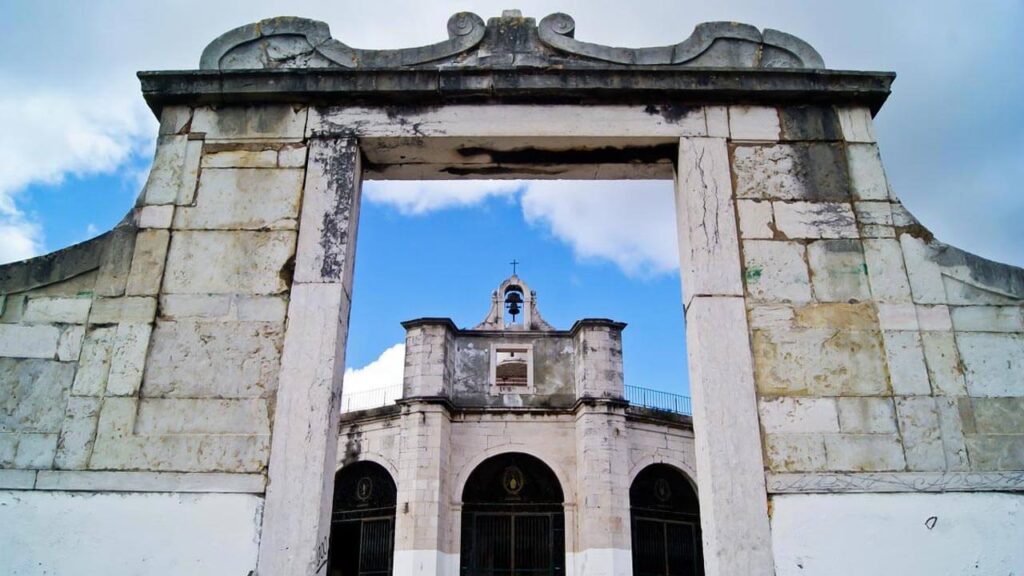Original article published on 20 February 2019
Let’s explore the Santo Amaro Chapel in Lisbon, an Architectonic Gem from the 16th Century, with a circular plan and an arcade completely covered with magnificent polychromatic tiles!
Located in the Neighbourhood of Santo Amaro, in the parish of Alcântara, in the West zone of Lisbon, classified as a national monument since 1910, this chapel is, without a doubt, one of the oldest and most peculiar buildings of Lisbon.
We suggest you go to Rua 1º de Maio, next to the Carris Museum and go up the stairs that begin right at the start of Calçada de Santo Amaro, just like the pilgrims that used to go there during times of festivities and pilgrimages.
By reaching the top you can rest while admiring the magnificent view and then calmly visit the small but rich temple.
First, let’s find out which Saint this is and how his cult started and was lived in this place
Saint Amaro

Saint Amaro was a friar of the Order of Saint Benedict, schooled from a young age by Saint Benedict himself, who appreciated his virtuous character dedicated to sacrifice and sanctity.
He was therefore responsible for founding the Glanfeuil Abbey, the first French Benedictine monastery, of which he was the abbot for 38 years and where he passed away on 15th January 584.
His dedication to the weak and unfortunate, as well as the countless miracles became famous; and his healing abilities, mainly related to the limbs, led to arms and legs becoming his attributes.
Sculpted in wood and stone, painted in tiles or forged in iron, the iconography of the saint is present in every decorative element of the chapel
Origins and Experiences of the Santo Amaro Chapel in Lisbon
The Legends
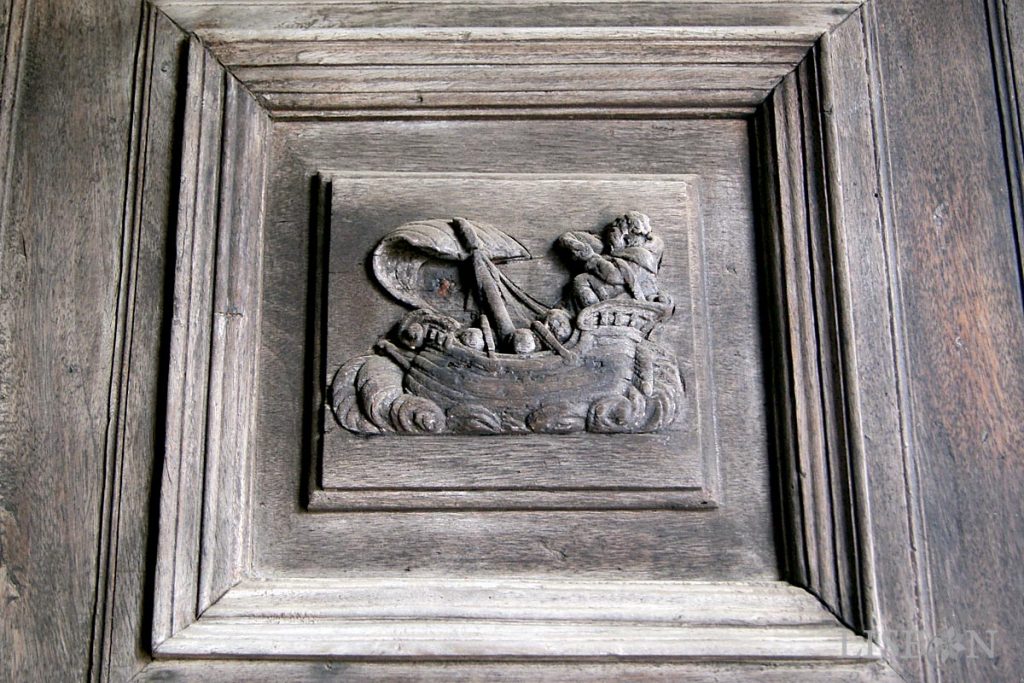
There are two versions of the origin of this chapel.
The first one says that Galician sailors lost in the sea promised Saint Amaro the construction of a chapel where they could anchor safely. This happened in the place where the staircase begins, which gives access to the chapel on the top of a hill overlooking the river.
The other version says that 14 friars from the Military Order of Christ when returning from a pilgrimage to St. John Lateran in Rome, decided to initiate a mystic religious life in a deserted place. For that, they instituted a brotherhood and built the Santo Amaro Chapel in Lisbon with the authorization of the monarch King João III.
Regardless of which version is true, what is certain is what is stated in an inscription on the door of the temple where we can still today read: “COMEÇOUSE A EDIFICAR ESTA ERMIDA DE SANTO AMARO A DOZE/ DIAS DE FRO DO ANO D 1549 ANOS E AVIA SETE ANOS QUE HERA/ AQUI EDIFICADA A QUE AGUORA SERVE DE SACRISTIA”.
This means that the first construction was simply a small space of cult built in 1542, which corresponds to the current sacristy, having the chapel been built in 1549.
It was likely during the same period that the four olive trees were planted in the backyard garden of the chapel, which are now classified as Public Interest Trees.
The Festivities in Honour of Saint Amaro
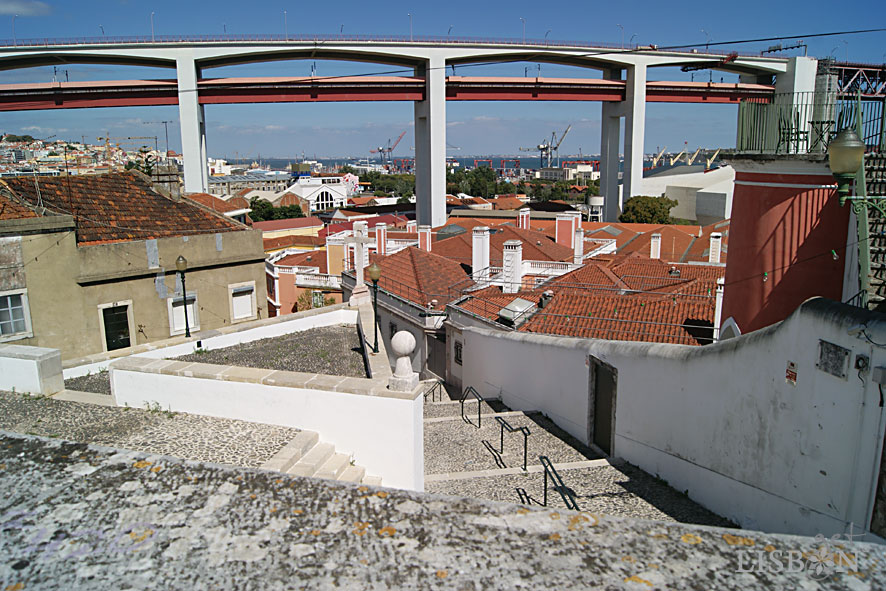
It is true that the friars of the Military Order of Christ gave rise to the Royal Confraternity of the Blessed Saint Amaro of Alcântara of which the highest nobility, including kings, princes and patriarchs were part of. It benefitted from great honours and privileges, as well as the title of Royal.
Every year there were festivities in honour of the saint that counted with the presence of the most distinct personalities of the time.
The extinction of the religious orders in 1834 affected the brotherhood, and the chapel was then handed over to the parish of Alcântara. With the abandonment of the temple by the nobility, the cult of the saint wasn’t lost, but started being more common among the popular social strata.
The square of the Santo Amaro Chapel in Lisbon was embellished with flags, flowers, garlands and colourful paper balloons, to have the people gathered dancing and singing. All kinds of traditional products and delicacies were sold in the area: cakes, pastries, sweets and dried fruits, the most famous of which were the pine nuts as beads in necklaces, which everyone wore around their necks. Behind the chapel stood the food and beverage stalls.
The festivities that took place between 15th January and 2nd February were even considered one of the largest festivities in Lisbon.
The many Galicians that at the time lived in Lisbon, were particularly devoted to this saint and on the first day of the festivities, they wouldn’t go to work and would go there early, wearing better clothing, playing bagpipes and castanets. At night fireworks were shot and many candles lit, whose gleam could be seen from the south bank of the Tagus River.
Although it was classified as a national monument in the same year of the implementation of the republic, 1910, this didn’t benefit the Santo Amaro Chapel at all.
Closed, desecrated, and stripped of its riches, it became a deposit of charcoal and the dwelling of poor people. But in 1927, it was handed over to the Brotherhood of the Blessed Sacrament, having the cult been resumed the following year


Description of the Santo Amaro Chapel in Lisbon
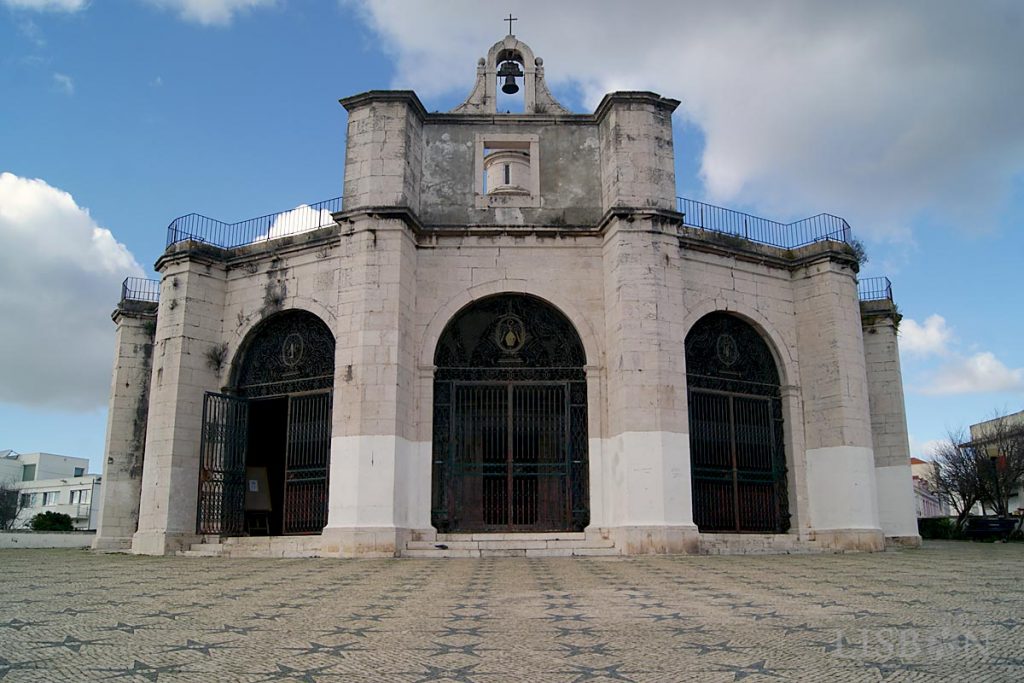
The architectural complex is constituted by the monumental staircase, interrupted by a landing with a cruise, ending in a portico decorated with volutes and the chapel itself. This is a central-plan building topped by a dome, whose conception is attributed to Diogo de Torralva, an architect who explored the Mannerist aesthetic.
Throughout the time decorative elements have been added, testimonies of the importance that was given to and that were valuing the architectural complex.
The body of the chapel is preceded by a semicircular arcade, with counterforts that flank five round arches. To the three open arches correspond admirable wrought iron doors added in the 18th century.
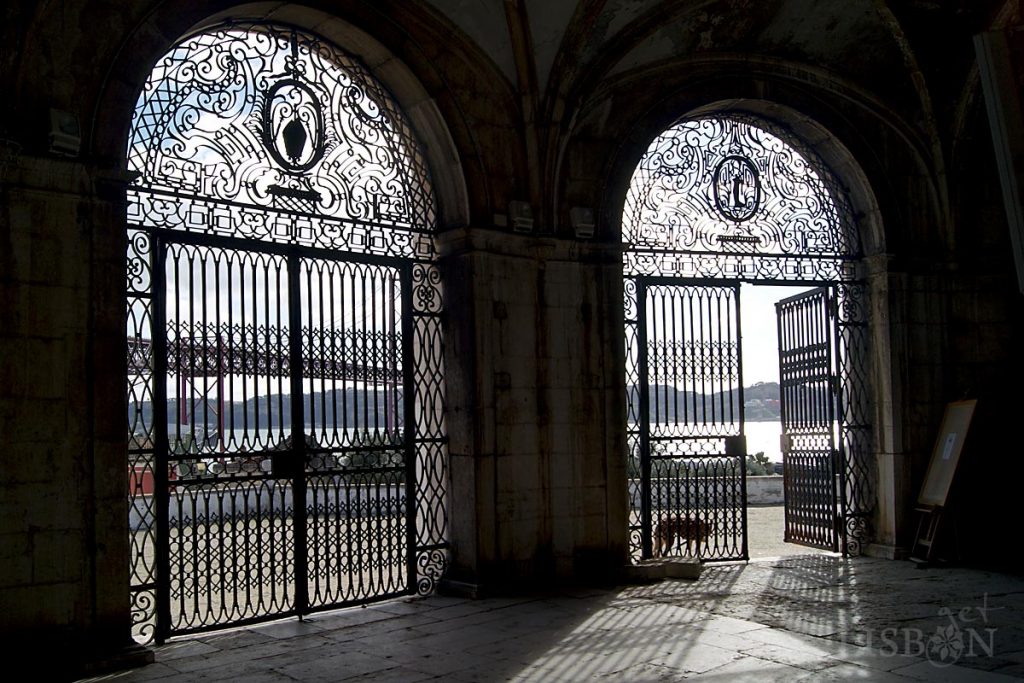
The arcade is covered by a rib vault, where attributes of the saint can be seen in sculpted stones. Its walls are completely covered with polychrome Mannerist tiles that are believed to be from the late 1500’s/early 1600’s, as well as the two altars built on the covered spans, one of them unfortunately in a deep state of degradation.
The inside of the chapel can be accessed through a flat arch portal on which is the inscription that we’ve already mentioned previously.
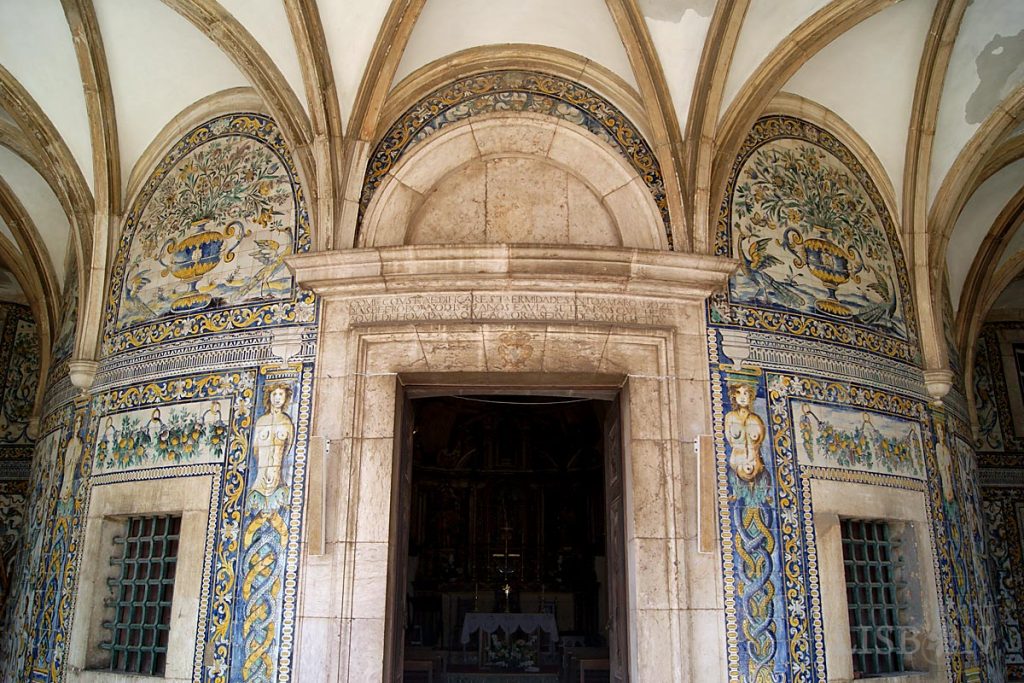
The wooden doors present curious reliefs that refer to the legend of the origin of the chapel and to the attributes of the saint.
The chapel’s body is covered by a hemispherical dome and there deserve to be highlighted two polychrome tile panels from the late 18th century from the Rato Royal Factory of Crockery, and two altars of baroque gilded woodcarving that flank the triumphal arch.
The main chapel also has a circular plan and a truncated hemispherical vault. The high altar is also covered in baroque gilded woodcarving with the same typology as the previous ones and displays two very dark paintings.
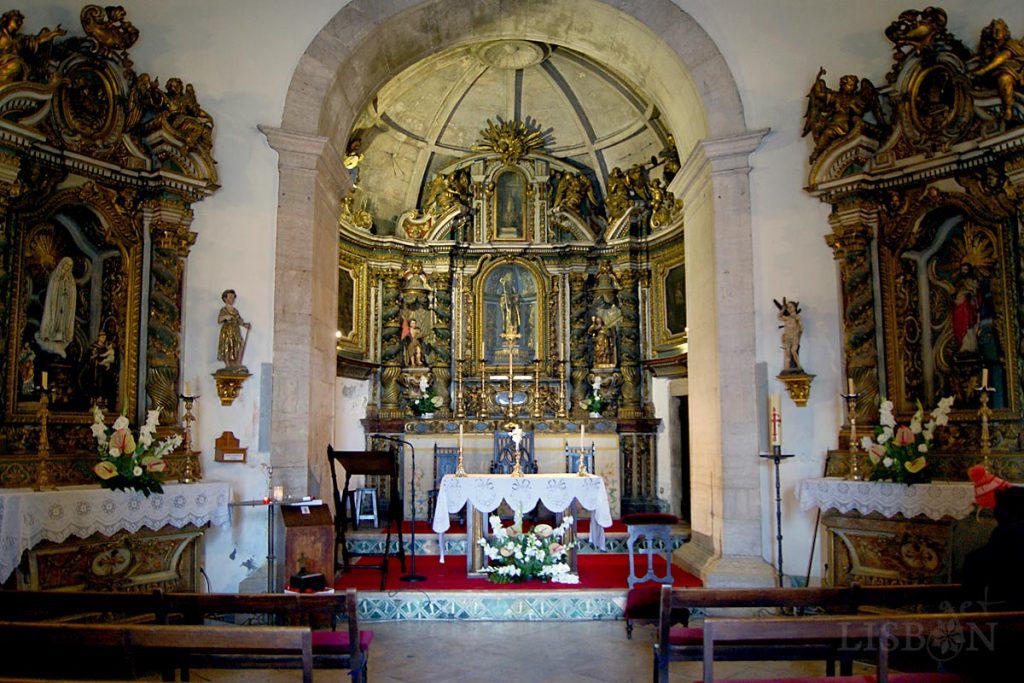
We must also highlight the sacristy that presents a sacristy credens where we can find a set of paintings that illustrate Saint Amaro’s life. The ceiling’s painting on wood and the marble washbasin mustn’t be forgotten either.
| Never miss another article | Subscribe here |
The Santo Amaro Chapel Today

Unfortunately, the Santo Amaro Chapel isn’t very well conserved. The urgent need for a deep intervention has been long talked.
After a period of about two decades of being closed, it is now possible to visit it from Tuesday to Friday and at the 1st and 3rd weekends of each month between 11am and 5.30pm. We suggest you attend the Changing of the Guard at the Belém Palace, which is always held on the 3rd Sunday of each month, and then go to the Santo Amaro Chapel that isn’t too far away.
As far as experiences are concerned, there are no longer Galician people and pine nut necklaces as in the past, but the Santo Amaro festivities, which are now held for 5 days in June and are part of the Lisbon Festivities, count every year with a procession, food and beverages, music concerts and entertainment that continue to attract the public.
Curious Facts
The Santo Amaro Chapel in Lisbon was classified as a National Monument in a decree dated 23rd June, 1910.
This decree lists numerous properties scattered throughout the country, from different eras and typologies. Prehistoric monuments, as well as hillforts, churches, bridges, pillories, among others are contemplated.
The Roman inscriptions of the Pedras Negras, curious Roman vestiges, which we’ve had the chance to tell you about in another article of ours, are part this list.
Two of five of the surprising portals between Alfama and Mouraria that we’ve compiled for you were too classified as national monuments at the time. These were the main portal of the Madalena Church and the side portal of the old palaces of São Cristóvão in Rua do Regedor.
Alongside the emblematic monuments such as the Lisbon Cathedral, the Jerónimos Monastery and the Estrela Basilica, the Church of Conceição Velha was also classified, whose story is told through feminine figures, another article of ours we invite you to read now.
The project getLISBON has been very rewarding and we want to continue revealing the singularities of fascinating Lisbon.
Help us keep this project alive!
By using these links to make your reservations you’ll be supporting us. With no extra costs!
• Looking for a different experience? We can create a customised itinerary based on your interests. Contact us!
• Or if you prefer tours and other activities in various destinations, take a look at GetYourGuide.
• Save time and money with a flexible Lisbon Card!

